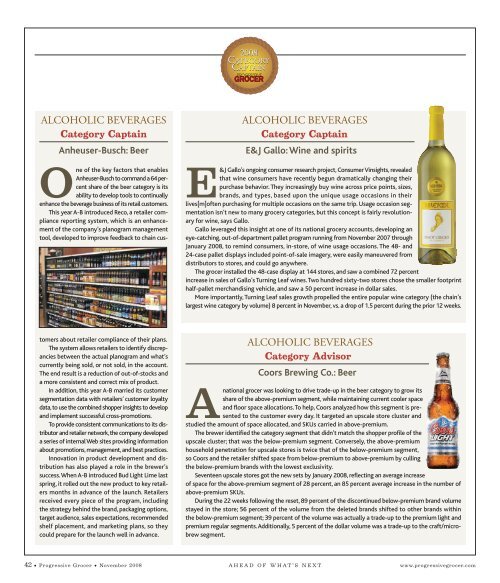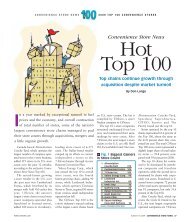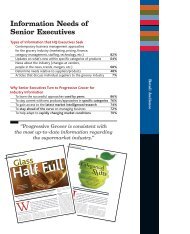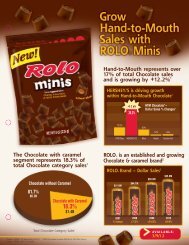MARCHING ORDERS - Progressive Grocer
MARCHING ORDERS - Progressive Grocer
MARCHING ORDERS - Progressive Grocer
You also want an ePaper? Increase the reach of your titles
YUMPU automatically turns print PDFs into web optimized ePapers that Google loves.
ALCOHOLIC BEVERAGES<br />
Category Captain<br />
Anheuser-Busch: Beer<br />
ALCOHOLIC BEVERAGES<br />
Category Captain<br />
E&J Gallo: Wine and spirits<br />
E&J Gallo’s ongoing consumer research project, Consumer Vinsights, revealed<br />
that wine consumers have recently begun dramatically changing their<br />
purchase behavior. They increasingly buy wine across price points, sizes,<br />
brands, and types, based upon the unique usage occasions in their<br />
lives[m]often purchasing for multiple occasions on the same trip. Usage occasion segmentation<br />
isn’t new to many grocery categories, but this concept is fairly revolutionary<br />
for wine, says Gallo.<br />
Gallo leveraged this insight at one of its national grocery accounts, developing an<br />
eye-catching, out-of-department pallet program running from November 2007 through<br />
January 2008, to remind consumers, in-store, of wine usage occasions. The 48- and<br />
24-case pallet displays included point-of-sale imagery, were easily maneuvered from<br />
distributors to stores, and could go anywhere.<br />
The grocer installed the 48-case display at 144 stores, and saw a combined 72 percent<br />
increase in sales of Gallo’s Turning Leaf wines.Two hundred sixty-two stores chose the smaller footprint<br />
half-pallet merchandising vehicle, and saw a 50 percent increase in dollar sales.<br />
More importantly,Turning Leaf sales growth propelled the entire popular wine category (the chain’s<br />
largest wine category by volume) 8 percent in November, vs. a drop of 1.5 percent during the prior 12 weeks.<br />
One of the key factors that enables<br />
Anheuser-Busch to command a 64 percent<br />
share of the beer category is its<br />
ability to develop tools to continually<br />
enhance the beverage business of its retail customers.<br />
This year A-B introduced Reco, a retailer compliance<br />
reporting system, which is an enhancement<br />
of the company’s planogram management<br />
tool, developed to improve feedback to chain customers<br />
about retailer compliance of their plans.<br />
The system allows retailers to identify discrepancies<br />
between the actual planogram and what’s<br />
currently being sold, or not sold, in the account.<br />
The end result is a reduction of out-of-stocks and<br />
a more consistent and correct mix of product.<br />
In addition, this year A-B married its customer<br />
segmentation data with retailers’ customer loyalty<br />
data,to use the combined shopper insights to develop<br />
and implement successful cross-promotions.<br />
To provide consistent communications to its distributor<br />
and retailer network, the company developed<br />
a series of internal Web sites providing information<br />
about promotions, management, and best practices.<br />
Innovation in product development and distribution<br />
has also played a role in the brewer’s<br />
success.When A-B introduced Bud Light Lime last<br />
spring, it rolled out the new product to key retailers<br />
months in advance of the launch. Retailers<br />
received every piece of the program, including<br />
the strategy behind the brand, packaging options,<br />
target audience, sales expectations, recommended<br />
shelf placement, and marketing plans, so they<br />
could prepare for the launch well in advance.<br />
ALCOHOLIC BEVERAGES<br />
Category Advisor<br />
Coors Brewing Co.: Beer<br />
Anational grocer was looking to drive trade-up in the beer category to grow its<br />
share of the above-premium segment, while maintaining current cooler space<br />
and floor space allocations.To help, Coors analyzed how this segment is presented<br />
to the customer every day. It targeted an upscale store cluster and<br />
studied the amount of space allocated, and SKUs carried in above-premium.<br />
The brewer identified the category segment that didn’t match the shopper profile of the<br />
upscale cluster; that was the below-premium segment. Conversely, the above-premium<br />
household penetration for upscale stores is twice that of the below-premium segment,<br />
so Coors and the retailer shifted space from below-premium to above-premium by culling<br />
the below-premium brands with the lowest exclusivity.<br />
Seventeen upscale stores got the new sets by January 2008, reflecting an average increase<br />
of space for the above-premium segment of 28 percent, an 85 percent average increase in the number of<br />
above-premium SKUs.<br />
During the 22 weeks following the reset, 89 percent of the discontinued below-premium brand volume<br />
stayed in the store; 56 percent of the volume from the deleted brands shifted to other brands within<br />
the below-premium segment; 39 percent of the volume was actually a trade-up to the premium light and<br />
premium regular segments.Additionally, 5 percent of the dollar volume was a trade-up to the craft/microbrew<br />
segment.<br />
42 • <strong>Progressive</strong> <strong>Grocer</strong> • November 2008 A H E A D O F W H AT ’ S N E X T www.progressivegrocer.com





